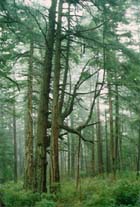Look, there is a point to all of this. And the point is your life and the lives of those you cherish.
Your garden is your dream of bliss made manifest, heaven on earth. Bureaucracy, cheats, liars, endless line-ups, bad hair days got you down? Retire to your garden and make life whole.
You get out what you put in. Gardens are alive, everything changes every day, whether you think you don't notice it or you think you do. A great garden embodies a great vision. What is the mark of a successful businessperson? Never quit! The same applies to your garden. Gardens are the art of the possible. Take your idea, your innermost thought-sanctuary and let it live! Let it breathe free air, spring wholesome water, bring joy and upwelling heart laughter.
 |
Perhaps this is all too poetic for you and you enquire here to know of the experience and capability of the designer. After all, you are probably searching here in hopes of finding assistance to realize the dream. Very well. Each habitat type has a different internal ecological structure. The deciduous temperate North American forest, for example, has two or three layers of vegetation, interior species of birds and other animals, and is continuously somewhat moist. In contrast, the single layer of grasses in an old field (which gives way to sedges or rushes in wetter soils) harbours interior field birds and other species of animals and -- depending on the season and the weather -- is either dry or wet. Each habitat type offers a different sensory experience: the deciduous forest is cool and shaded and can feel enclosed; the old field can feel exposed and may offer views and is often brightly sunny.
Your garden finds its inspiration in your values and beliefs. At the same time, it is rooted through the specific habitat type (temperate forest, field, hot desert, etc.), through the history of the locale, or through familiar cultural motifs (artistic symbols, patterns, styles) that may occur in your area. In garden making, shape spaces, build bridges, bring light, give rhythm, tell a story.
 |
What is true for a personal garden is also true in a corporate or public setting. The setting for a private development embodies the values of cost-effectiveness, appeal and marketability to the ultimate land-owners, and timeliness. Other principles of landscape design serve these ends.
Public projects emphasize public values as expressed through the mandates of government land agencies and municipal administrations.
 |
SUSTAINABLE HUMAN ENVIRONMENTS Landscape architecture is about relationships among individuals, within community, and between humans and nature (ecological processes). The aim is to create places that are economically efficient, ecologically sound, which provide for their own needs, do not pollute but find in "wastes" a marketable by-product, and do not exploit for short term gain but seek long-term profit/income.
WATER Water is the key element: we who dwell in cities (and that's most of the Earth's population) have forgotten the rich taste of wholesome waters -- generally it tastes like metal pipes, doesn't it? -- and if we're in the developing world, it is a daily life-and-death struggle, we're thankful if it is disease-free. Without water: no life. Without clean water: no health. Without wholesome water: no awareness. It is a worthwhile and challenging aim to " just" bring accessible clean ongoing/sufficient/bountiful/adequate water to every human being.
 |



